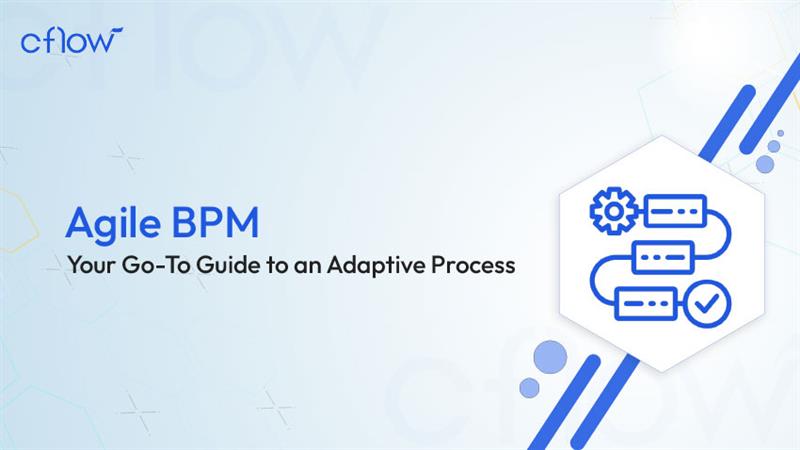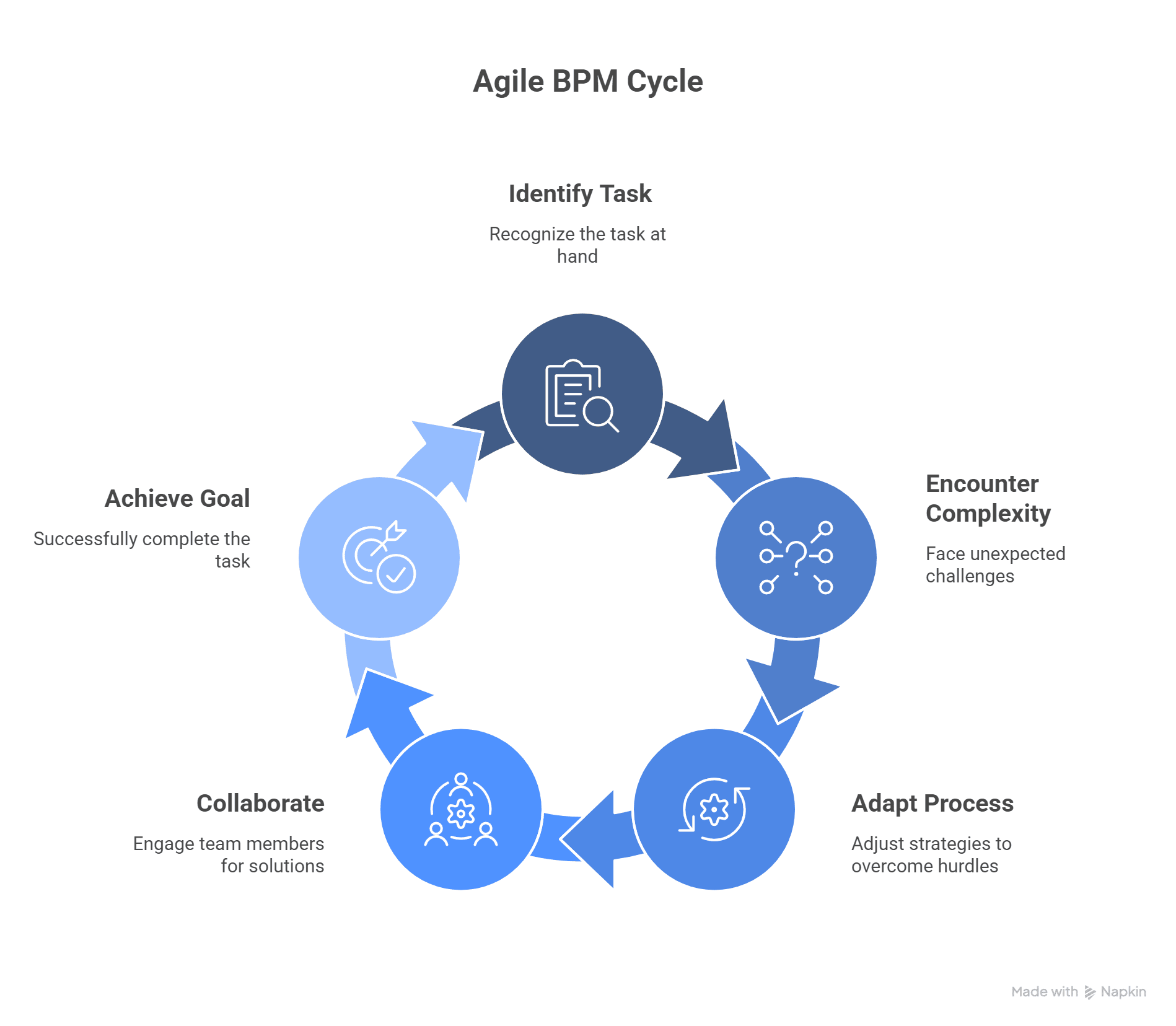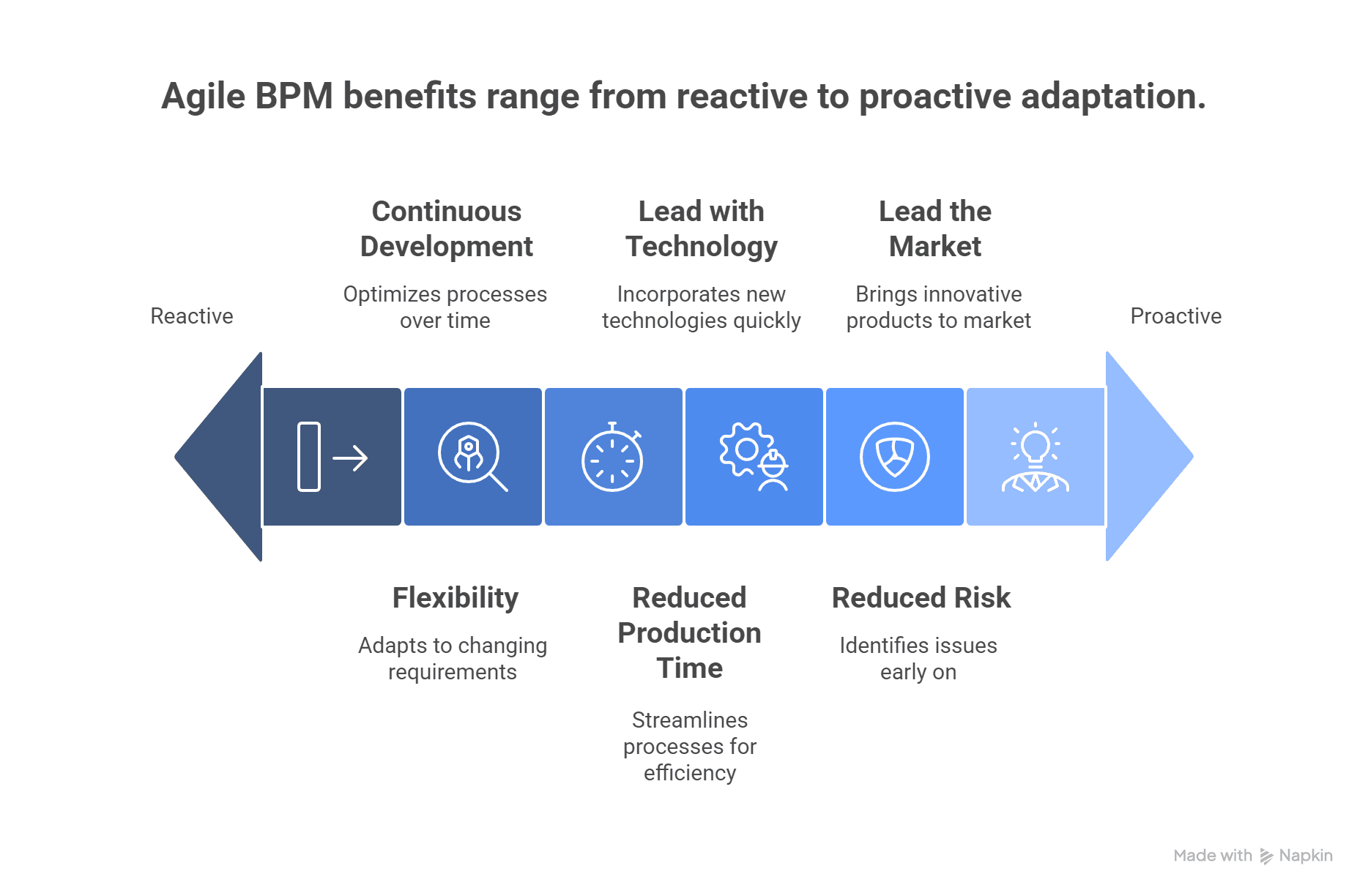Agile BPM: A Comprehensive Guide To Endorse Agile Business Practices

Key takeaways
Agile BPM combines flexibility with process discipline to manage change, complexity, and unpredictability in modern business environments.
Traditional BPM is rigid and best suited for structured, repeatable tasks, while Agile BPM adapts quickly to unplanned inputs and dynamic conditions.
Agile BPM works through iterative development, continuous feedback, and real-time adjustments to optimise business performance.
Agile BPM improves operational efficiency, reduces risks, accelerates time-to-market, and enables rapid adoption of new technologies.
Agile BPM promotes collaboration between departments, breaking down organisational silos and bridging the gap between IT and business teams.
Businesses operating in fast-changing or unpredictable environments benefit most from agile process improvement frameworks.
Cflow, a cloud-based BPM tool, supports Agile BPM through visual workflows, real-time feedback, easy updates, and seamless collaboration.
Implementing Agile BPM requires a cultural shift towards flexibility, continuous improvement, and technology-enabled process control.
“Expect the unexpected” has become the new normal in the post-pandemic world, and organisations across the UK are learning to adapt. But what about your business strategies and BPM (Business Process Management) approach? Are they equipped to handle today’s fast-changing environment? To stay ahead of market trends, the answer must be yes, and that means embracing Agile BPM.
How does your current BPM system respond to a sudden disruption or an unpredictable input?
In most cases, traditional BPM frameworks tend to stall or falter when faced with unexpected variables. That’s where the need for agility becomes clear. Moving from conventional BPM to agile BPM isn’t just a trend — it’s a business necessity.
Simply put, the demand for a more adaptive and resilient BPM model has given rise to Agile Business Process Management. This approach ensures that businesses can continue to operate efficiently, even in uncertain conditions. In this blog, we’ll explore the agile BPM methodology, its key benefits, where it fits best, and why it’s crucial for your organisation to embrace agile business practices today.
What is Agile BPM?
Agile BPM is a modern way of managing and improving business processes by combining the flexibility of agile thinking with the structure of Business Process Management. It helps businesses become more responsive, efficient, and better at handling change, all while automating daily operations.
Even the best-planned processes can face sudden surprises, like an urgent client request, a system breakdown, or a delayed payment. That’s where Agile BPM stands out. It allows your business to respond quickly to unexpected situations without slowing down or breaking the workflow.
At its core, agility means being ready for the unplanned. Agile BPM makes this possible by accepting variable inputs and providing a framework to manage them smoothly. The process doesn’t stop — it adapts, continues, and keeps your business running.
BPM VS Agile BPM
| Aspect | Traditional BPM | Agile BPM |
|---|---|---|
| Approach | Linear: processes are documented, analysed, and optimised in fixed steps | Iterative: focuses on small changes, regular feedback, and ongoing improvements |
| Flexibility | Low flexibility — works best with structured, repeatable tasks | High flexibility — adapts quickly to unexpected changes or ad hoc inputs |
| Response to Change | Slower to respond to market or internal changes | Fast response with real-time adaptability |
| Input Handling | Works with predefined, expected data | Accepts variable and unplanned inputs (e.g., tool failure, delays, unexpected requests) |
| Process Automation | Automates fixed, clearly defined workflows | Automates while adapting on-the-fly to new scenarios |
| Business Environment Suitability | Best for stable, rule-based processes | Ideal for dynamic, fast-changing environments |
| Goal | Focuses on achieving fixed process improvement goals | Focuses on continuous improvement and agile adaptation to evolving needs |
| Speed of Implementation | Slower to implement and change | Faster development and quicker resolution of issues |
| Innovation Support | Limited, due to rigid structure | Encourages innovation through experimentation and constant feedback |
| Use Case | Suited for compliance-heavy or highly structured industries | Perfect for industries where flexibility and speed matter most |
“If you can orchestrate things in unforeseen circumstances without stopping the whole process — that’s exactly how Agile BPM works.”
Example of Agile BPM
BPM methodology works at the pace of inputs being fed into them; however, it follows a predictive pattern to process them, and they don’t react to real-time or instant changing feedback.
For example, when a scrum development team is working on a website build, they are juggling when the client keeps changing their input for website development. Agile BPM comes in handy here.
There may be instances where your fixed nuances for one process are to be handled and utilised by other departments for some reason. This provokes an internal glitch with regular BPM, while the Agile business process’s ability to pivot without interrupting business operation is its core resolute nature. To be more precise, regular BPM effectively deals with the structured process (like sales) while the dynamic process (marketing scenarios) holds a fair deal with agile BPM.
Discover why teams choose Cflow
What is Agile Business Process Mapping?
Business process mapping is a visual representation of the business processes with the steps involved in the process from start to end. Agile business process mapping outlines the various tasks to be accomplished and the roles and responsibilities by using a visual representation, like a map or chart diagram.
In agile business management, the steps taken throughout the customer journey are mapped as every unforeseen circumstance is unique to every other user, and the steps involved with every user story differ. Thus, agile BPM focuses more on improving the end-user experience.
How Does Agile BPM Work?
Think of traditional BPM like a fixed train track; it works great when everything is planned and on schedule. But the moment something unexpected appears on the track, everything grinds to a halt. There’s no room to shift course or adapt in real-time.
Agile BPM, on the other hand, is like a GPS-guided smart car. It doesn’t just follow one route — it responds to traffic, weather, and even roadblocks. It reroutes instantly, making sure you reach your goal no matter what pops up. It’s built to handle unpredictability.
Let’s look at two common situations to see Agile BPM in action:

Scenario 1: When Routine Tasks Need Extra Know-How
Cause: You’re processing a Purchase Order (PO). It seems routine, but suddenly you hit a point that needs domain-specific knowledge, like understanding vendor terms or budget constraints.
Effect: Agile BPM doesn’t stop here. It allows you to pause, pull in expert input or extra documentation, and continue the process without restarting or delaying everything. It adapts as you go.
Scenario 2: When Simple Tasks Turn Out Complex
Cause: A task seems simple at first, but turns out to be more layered, like onboarding a new vendor involving multiple approvals, documents, and validations.
Effect: Agile BPM helps break this into smaller, manageable tasks. It involves multiple team members, collects inputs in real time, and accelerates completion through collaboration.
Agile BPM is built for the real world, where not everything goes as planned. It lets your processes breathe, adapt, and move forward, even when surprises show up.
You can get started with Cflow for free
Why is Agile BPM important?
Business needs keep changing
Customer demands, market trends, and new technologies are constantly evolving. Your business processes must be able to change with them.Agile BPM helps you stay adaptable
Unlike traditional BPM, Agile BPM allows you to update, modify, or improve processes on the fly, without breaking the system.Traditional BPM is rigid
It works well only for fixed, repeatable tasks. When the unexpected happens, traditional BPM struggles to cope.Can’t we just tweak traditional BPM to handle surprises?
It sounds logical — but unfortunately, no. Planning for every possible ad-hoc scenario in advance just doesn’t work.Why not? Because ad-hoc = unpredictable
You can’t design a fixed rule for something you can’t see coming. Trying to do so usually leads to confusion, errors, or missed steps.Planning for unpredictability wastes time
You’ll spend more time trying to map out “what ifs” than actually getting work done. And chances are, you’ll still miss something important.
Key Benefits of Agile BPM That Fit Your Business Model
Agile BPM offers several benefits over traditional BPM. Here are some of the key benefits of agile business management:

1. Flexibility:
Agile process improvement methodology is designed to be flexible and adaptable, allowing organisations to respond quickly to changing business requirements and market conditions.
2. Continuous Development:
Continuous improvement is essential for organisations that want to stay competitive and improve their operational efficiency. Agile BPM emphasises continuous improvement, allowing organisations to refine and optimise their processes over time.
3. An End of Organizational Silos:
Agile business practices emphasise continuous improvement so that processes can be refined and optimised over time based on feedback and insights gained from customers.
4. Reduced Production Time:
Customers expect fast, efficient, and personalised service. Agile BPM allows organisations to deliver on these expectations by streamlining and optimising key business processes. Agile business practices allow for more rapid and flexible development of process models, which can be developed and refined in an iterative and collaborative manner.
5. Lead with Technology to Transform:
Digital transformation is changing the way that many businesses operate, and organisations need to be able to adapt their processes to take advantage of new technologies. Agile for business allows organisations to quickly adopt new technologies and incorporate them into their processes.
6. Reduced Risk:
Agile business management reduces risk by breaking down the process into smaller, more manageable pieces and testing each piece in an iterative and collaborative manner. This helps to identify and address issues early before they become larger problems.
7. Lead the Market:
Agile business processes can help organizations to bring new and innovative products or services to market more quickly by streamlining and optimising key business processes at a creative and quick pace.
8. Improved Collaboration:
Agile BPM promotes collaboration and communication among stakeholders, including process owners, developers, and end-users, which helps to ensure that the process is designed and implemented in a way that meets the needs of all customers.
9. Bridge the Culture Gap:
The business operations and IT department work on different horizons, though both equip the organisation towards excellence. You can experience the lapse bridged with agile business process mapping.
Try Cflow for free, no credit card needed
Best Practices for Agile BPM: Making BPM More Agile
Organisations can foster a few key practices to revel in the benefits of agile BPM to unfurl its flexible nature in unforeseen circumstances. Here is a quick walk-through to make your BPM more agile.
1. Identify and Simplify:
Identify a process that needs improvement and determine the scope of the project, including the process objectives, end users, and other success metrics. Rather than trying to optimise the entire process at once, break it down into smaller, more manageable pieces that can be developed and refined in an iterative and collaborative manner. Break the process down into smaller, more manageable pieces and develop each piece in an iterative and collaborative way.
2. Embrace an Iterative Approach:
Develop a plan for each iteration, including the objectives, timeline, and deliverables. Use the task and time management tool to define every participant’s roles and responsibilities. Ensure reading the real-time data inputs to improve each iterative stage with new technologies. Look for a solid measurement procedure to analyse the effectiveness of the evolving changes.
3. Prioritise Flexibility:
Design the process to be flexible and adaptable, so that changes can be made quickly and efficiently based on changing business requirements or feedback from stakeholders. Choose a team that can adapt to this change and act flexibly to facilitate changes on the fly.
4. Incorporate Rapid Feedback:
Gather feedback from all the involved team members early and often, and incorporate it after each iteration. Use this feedback to refine and improve the process at each iteration, so that they don’t become huge issues later.
5. Emphasise Continuous Improvement:
Continuously monitor and evaluate the process, and make ongoing improvements based on feedback and insights gained from stakeholders.
6. Utilise Technology:
Use technology to streamline and automate the process, and to enable more efficient collaboration and communication among stakeholders. Agile BPM can be a good fit for businesses that operate in dynamic environments, value continuous improvement and innovation, and are looking to improve operational efficiency and leverage technology to improve business processes.
7. Build a Mindset of Agility:
It’s time to change from that old-school, rigid BPM to a simple mindset of agile process control. Your teams should be encouraged to work in a dynamic environment with an attitude expecting processes to change anytime and knowing you have control over them with agile BPM.
8. Foster Collaboration:
Encourage collaboration and communication among stakeholders, including process owners, developers, and end-users, to ensure that the process is designed and implemented in a way that meets the needs of all stakeholders.
End-to-end workflow automation
Build fully-customizable, no code process workflows in a jiffy.
How Does Agile Suit My Business?
Whether or not agile BPM is a good fit for your business depends on a number of factors, including the nature of your business, your organisational culture, and your business goals. However, here are some general, considerable queries that can help you determine if agile process improvement methodology is a good fit for your business:
- Does your business operate in a dynamic environment with changing business requirements?
- Does your business involve many processes that are hardly predictable?
- Do you need your business processes to be quickly responsive to your business needs without staggering the orchestration framework?
- Is your business framework focused on the refinement and optimisation of your business processes?
- Does your business entitle highly qualified employees not to indulge in value-added tasks?
- Do you aim for a collaborative approach in your business model where data flows are hassle-free?
If you nod up and down, then it’s time to build the responsive realm of BPM: The agile methodology. The below section entails an effective measure to do so.
Transform your AI-powered approvals
Building an Agile BPM Approach with Cflow
The cloud-based BPM solution. Cflow helps organisations implement an agile BPM approach by providing a flexible, collaborative, and efficient platform for process development, refinement, and optimisation.
- The flexible and adaptable nature of Cflow allows organisations to respond quickly to changing business requirements and market conditions. The workflow in the Cflow framework is easy to develop and deploy your business processes in an agile manner.
- The drag-and-drop interface and pre-built workflow templates enable users to quickly create and modify workflows. Workflows can be modified and updated on the fly, without requiring extensive development work, which is what agile process improvement methodology is known for.
- Cflow provides real-time analytics and reporting so that organisations can gather feedback from stakeholders early and often, and use this feedback to refine and improve the workflow at each iteration.
- Easy collaboration and continuous improvement are facilitated by the platform embarking on the refinement and optimisation of workflows.
- Cflow provides a governance framework that ensures that workflows are consistent, standardized, and meet compliance requirements and lets your team be informed about and effectively participate in the agile business management process.
Final Thoughts
Business conditions rarely remain the same — priorities shift, demands evolve, and challenges often arrive without warning. Agile BPM offers a practical way for organisations to manage this uncertainty by building flexibility directly into their processes.
However, agility doesn’t happen by chance. It requires the right mindset, a clear plan, and the right technology to support it.
That’s where Cflow comes in. As a flexible, cloud-based BPM solution, Cflow equips your team to implement agile business practices with confidence, offering visibility, adaptability, and control across every step of the workflow.
Make agility part of your operating rhythm.
Try Cflow and transform the way your business works.
Frequently Asked Questions
1. What is Agile BPM, and how is it different from traditional BPM?
Agile BPM blends agile principles with business process management. Unlike traditional BPM, which is rigid and linear, Agile BPM is flexible, iterative, and capable of adapting to unplanned changes without disrupting business operations.
2. Is Agile BPM only suitable for IT teams or software development?
No. While Agile principles began in software, Agile BPM benefits all departments — HR, finance, marketing, procurement — by making processes more responsive, collaborative, and efficient across the organisation.
3. Can Agile BPM handle compliance-heavy processes?
Yes. With the right BPM tool like Cflow, you can maintain audit trails, role-based access, and real-time documentation while still staying agile and adaptable to unexpected process changes.
4. Does my business need to replace its entire BPM system to go agile?
Not necessarily. Many organisations start by introducing agility into high-impact workflows or dynamic areas like marketing, onboarding, or approvals, then scale gradually with tools that support both traditional and agile models.
5. What are the top benefits of using Agile BPM?
Agile BPM delivers faster process changes, reduced operational risk, better stakeholder collaboration, quicker time-to-market, and continuous process improvement — all essential for modern businesses facing rapid change.
6. How do I know if Agile BPM suits my business?
If your processes are frequently disrupted by unexpected requests, if teams struggle with siloed workflows, or if flexibility is a priority, Agile BPM is likely a strong fit.
7. How does Cflow support Agile BPM?
Cflow enables agile workflows through a no-code interface, drag-and-drop builders, real-time analytics, and rapid deployment. It allows teams to iterate, collaborate, and adapt processes easily without relying on IT teams for changes.
8. Is Agile BPM expensive or difficult to implement?
Not with the right platform. Cflow offers a cost-effective and user-friendly way to implement Agile BPM. Most teams can start with minimal training and scale as needed, with no coding required.
Related Articles:
- Best BPM Companies to Consider in 2025
- What is BPMS? (Business Process Management System)
- What is Business Process Modelling and How to Implement it?
- 5 Business Processes Every Company Will Need To Automate
- Best Ways to Automate Business Processes in 2025
- What is a BPM Platform? A Complete Guide to Business Process Management in 2025
- Understanding the Need for BPM Solutions for Successful Business Operations
- BPM Tools to Manage Your Business Online
- Top 15 Business Process Management Software to Consider for 2025
What should you do next?
Thanks for reading till the end. Here are 3 ways we can help you automate your business:

Do better workflow automation with Cflow
Create workflows with multiple steps, parallel reviewals. auto approvals, public forms, etc. to save time and cost.

Talk to a workflow expert
Get a 30-min. free consultation with our Workflow expert to optimize your daily tasks.

Get smarter with our workflow resources
Explore our workflow automation blogs, ebooks, and other resources to master workflow automation.

